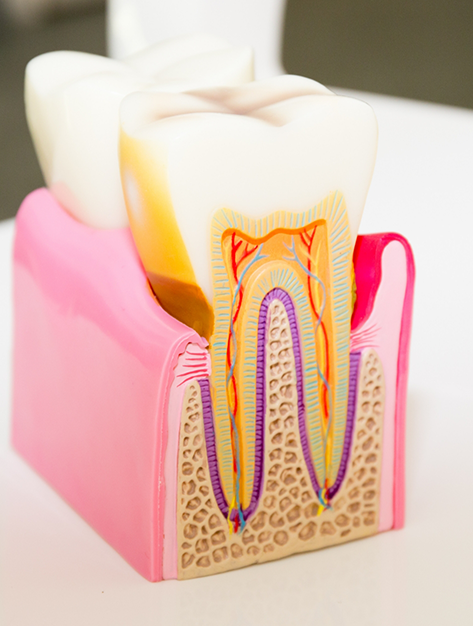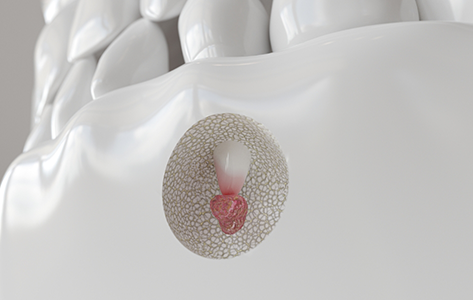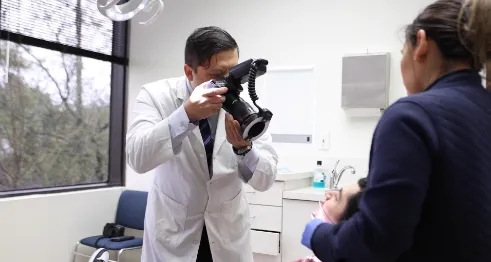Apicoectomy Surgery Houston
Preserving Your Natural Smile

If you’ve had a root canal in a tooth and are now experiencing discomfort in it, it could be due to a resurfacing infection due to lingering bacteria in the root structure. The team at Piney Point Oral & Maxillofacial Surgery of Houston can help preserve your tooth with precise apicoectomy surgery in Houston, helping you avoid the need for restorative dental treatments as well as easing your pain. For questions or to schedule an appointment, contact our team today.
Why Choose Piney Point Oral & Maxillofacial Surgery of Houston for Apicoectomy Surgery?
- Preserving Teeth & Improving Oral Health & Comfort
- Team That Collaborates with General Dentists
- We Accept Dental & Medical Insurance Plans
When Is Apicoectomy Surgery Necessary?

Your oral surgeon or dentist may have recommended apicoectomy surgery to try to save your tooth. To understand more about the procedure or why it is necessary, an appreciation for traditional endodontic (root canal) treatment is helpful.
When a tooth becomes sensitive or has deep decay, sometimes a root canal is necessary to remove the diseased tissue (blood vessels, connective tissue, and nerves) from the inside of the tooth. This tissue lies in a canal in the center of the root. During a root canal, an access hole is made in the top of the tooth and small instruments are used to remove this tissue and reshape the often flat or ribbon-shaped canal into a more rounded profile.
Once this is accomplished, the canal is sealed with a filling material to keep any residual diseased tissue from leaking out into the surrounding bone and causing irritation or infection. The goal of the root canal is twofold: one, to remove the tissue in the canal, and two, to seal the canal, especially in the portion near the tip of the root.
People tend to think of the root canals as discreet, round, simplistic systems. However, the canal system is usually somewhat flattened in profile and may contain branches or extra canals which are not visible or accessible with traditional techniques. Because of this, it may be impossible for anyone to successfully treat that particular tooth with the traditional root canal techniques. This is a problem that will not resolve itself or go away without some intervention. Oral antibiotics are never a satisfactory, long-term solution either because the source of infection has not been removed.
What Are Oral Surgery Options with a Failing Root Canal?

One solution would be to extract the tooth. The downside of this is that replacing teeth is extremely expensive, often several times the cost of treating the tooth. There is no substitute for a natural tooth.
A second option would be to retreat the tooth with the traditional technique. While this is not at all unreasonable, there are often some mitigating circumstances. In most cases, the tooth has been restored with a crown. Retreatment necessitates damaging that restoration by creating a large hole into the top of the tooth. An additional issue is more of a philosophical one. Most root canals fail not because of poor treatment but because of anatomic peculiarities that make treatment with the traditional techniques difficult or impossible. Those peculiarities are still present, and because of this, retreatment often has a relatively low success rate.
The third option is apical surgery (apicoectomy). This involves accessing the tip of the root directly and removing the diseased tissue, then preparing and filling the root tip itself. By making an incision in the gum tissue overlying the tooth, your surgeon then accesses the tip of the root. The root tip is then removed, and a small filling is made in the root tip and filled with a sealer to prevent further leakage of material out of the tooth. After a brief healing period, the gum tissue returns to normal.
The surgery itself is performed in an oral surgery office operating suite with either local anesthesia, IV sedation, or general anesthesia. While many patients prefer to have only a local anesthetic (the administration of numbing medicine to the area being worked on) more often, patients choose to be asleep or sedated. That is a decision best left up to the doctor and patient and can be explored more fully during your consultation visit.
What to Expect After Apicoectomy Surgery

Eventually, after several months, the cavity in the bone surrounding the tooth will fill in with new bone, completing the healing process. One may ask, how successful is this technique? The overall success is 80-85% after 10 years. A 10-year success will most likely continue to hold up for the life of the tooth. This is all the more remarkable when you consider that the procedure is typically performed on failing teeth to begin with.
Apicoectomy FAQs
What Are the Benefits of an Apicoectomy?
When you choose an apicoectomy, you take a proactive step toward preserving your natural tooth. This procedure allows us to treat infections or inflammation at the tip of your tooth’s root without the need for extraction. Keeping your own tooth helps maintain proper chewing function and prevents neighboring teeth from shifting, which supports your overall oral health.
We also find that an apicoectomy can be highly effective when previous root canal treatments have not resolved persistent issues. By addressing the problem at its source, we offer you a long-term solution that may allow you to avoid additional invasive procedures. Indeed, an apicoectomy has the potential to permanently ease your worry about your vulnerable tooth!
How Should I Care for My Mouth While I’m Recovering from an Apicoectomy?
Following an apicoectomy, it is important to keep your mouth clean and support healing. We recommend rinsing gently with a saltwater solution several times a day to reduce swelling and promote comfort. Brushing and flossing should continue, but you need to be gentle around the surgical area to avoid irritation.
We also advise you to avoid strenuous activities, refrain from touching the surgical site, and follow any prescribed medication schedule. Maintaining good oral hygiene and attending all follow-up appointments allows us to monitor your recovery and address any concerns promptly.
Our team will provide detailed postoperative instructions at the time of your procedure. You are always welcome to call us if any questions or concerns arise during your recovery period.
How Can I Protect My Treated Tooth from Additional Harm?
After an apicoectomy, safeguarding your treated tooth is vital for long-term success. We encourage you to avoid chewing hard or sticky foods on the affected side, since these can increase the risk of damage. Using a soft-bristled toothbrush and avoiding aggressive brushing helps prevent irritation in the area.
We also recommend wearing a mouthguard if you participate in contact sports or grind your teeth at night. Regular dental visits allow your general dentist to assess the health of your treated tooth and provide guidance on maintaining its strength.
How Much Does an Apicoectomy Cost?
The cost of an apicoectomy varies depending on the complexity of your case, the location of the affected tooth, and any additional procedures required. We understand that financial considerations are important, so we provide detailed estimates before treatment and discuss all available payment options with you.
Many dental insurance plans offer coverage for apicoectomy procedures, although the extent of coverage differs by provider. Often, 50% coverage is available, since an apicoectomy is typically classified as a major procedure. You may also have an annual maximum that limits how much your insurer will pay. Our team will be happy to help you figure out how your benefits may apply.
How Can I Know if an Apicoectomy or Tooth Extraction Is the Better Option?
Deciding between an apicoectomy and tooth extraction depends on your unique situation. We will evaluate the health of your tooth, the extent of the infection, and previous dental treatments to recommend the most suitable approach. Preserving your natural tooth is often preferable, provided the structure is strong and the infection is manageable.
If the tooth cannot be saved or poses ongoing health risks, extraction may be the better choice. We will discuss the advantages and drawbacks of each option during your consultation; our goal is to help you make a well-informed decision that supports your long-term oral health and overall health.
Wisdom Teeth Extraction Oral & Maxillofacial Pathology Oral Cancer Screenings Orthognathic Surgery Dental Implants Pre-Prosthetic Surgery Facial Trauma Treatment Cleft Lip & Palate Surgery TMJ Treatment Corrective Orthodontic Surgery Sleep Apnea Treatment Cosmetic Facial Treatments Anesthesia & Sedation Dentistry Emergency Dentistry View Our Services

